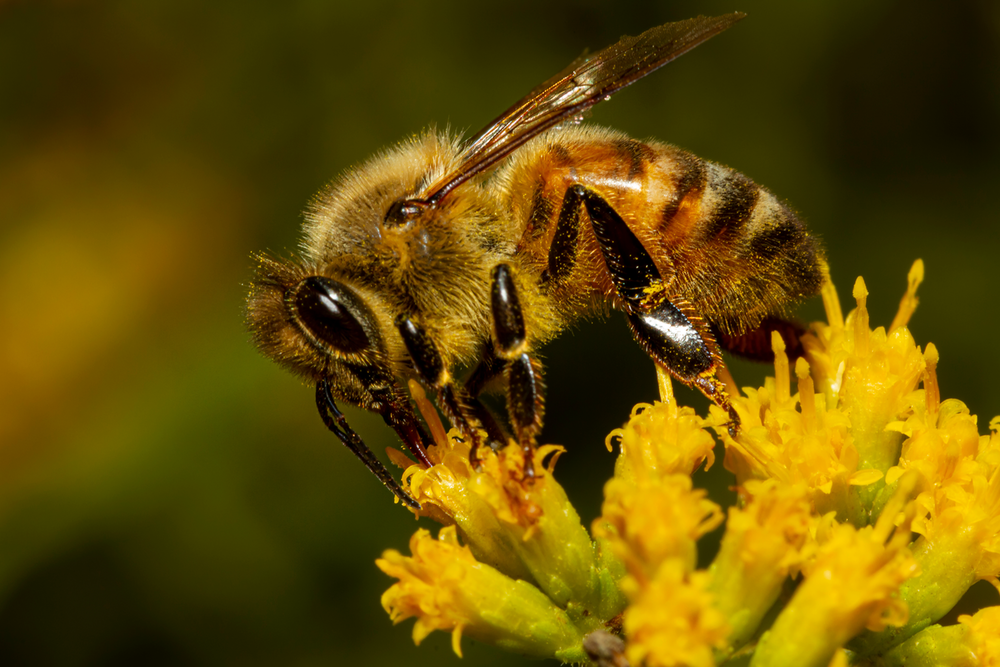Honeybee Tongue Hair Linked to Nectar-Collection Efficiency
Honeybees are always on the move, visiting on average around 2 million flowers to make a single pound of honey. All that flying is hard work, so it’s essential that honeybees efficiently collect the nectar they need to make their sweet, golden liquid. Scientists have long known that honeybees collect nectar using their tongue, which is covered in tiny hairs. But they remained in the dark as to the strategies honeybees use to maximize nectar intake. Now Jianing Wu at Sun Yat-sen University, China, and colleagues have mathematically and experimentally studied how a bee’s tongue-retraction time impacts its energy intake rate [1]. The team finds that the optimal retraction time correlates with the length and diameter of the hairs covering a honeybee’s tongue.
Honeybees have a long, thin, hairy tongue that rests inside a protective sheath. When a bee lands on a flower, that sheath opens and the bee’s tongue moves in and out of the sheath to collect nectar, which gets captured in the vertical spaces between the tongue’s hairs. The addition of nectar to the tongue increases the tongue’s diameter and thus its drag. As a result, tongue retraction is slower than tongue protraction (when the tongue is free of nectar and the hairs lay flat).
While the process of how honeybees drink is known, the impact of changes in the properties of each of the elements involved is not. To investigate that problem, Wu and his colleagues developed a fluid-transport model that includes each of the elements. Varying nectar concentration, tongue-hair unfolding time, and tongue length, they calculated the optimal tongue-retraction time—the shortest time in which the bees collected the most nectar—for six honeybee species with masses ranging from 12 to 256 mg.
The team finds that the optimal retraction time decreases with a honeybee’s body mass. For example, for the Western honeybee—which has an average mass of around 100 mg and is one of the world’s most common honeybee species—the model predicts an optimal retraction time of 135 ms. Meanwhile, for the Pearly-banded bee—which has a body mass of around 40 mg and lives in Southeast Asia—the optimal retraction is around 200 ms.
A honeybee’s body mass correlates with both its tongue length and its tongue-hair length-to-diameter ratio. Thus, the length-to-diameter ratio of tongue hairs also correlates with retraction time. The model also predicts slower retraction times for lower concentrations of nectar.
To verify these predictions, Wu and colleagues carried out experiments. They placed honeybees in a transparent setup, so they could observe the bees drinking. The team injected sugar water between two glass slides and then captured the motion of the bees’ tongues using a high-speed camera attached to a microscope focused on the slides. As in the model, Wu and colleagues found that retraction time decreased with body mass.
Wu hopes that his study will help in preserving honeybee populations, which have been declining for several years. Ensuring honeybees thrive is important for the health of our planet, Wu says. “If we lose honeybees, we lose 40% of our crops.” That sentiment is echoed by Fabian Brau, a physical chemist at the Free University of Brussels who has also studied how honeybees drink nectar. Brau says that the model created by Wu and colleagues could be used by communities to determine what flowers to plant, ensuring that local honeybee species have access to flowers with the nectar concentrations they need to collect it most efficiently.
Brau also notes that the predictions could shift thinking on the uniformity of behaviors of different honeybee species. Wu and colleagues show that the rate at which honeybees of a given species dip their tongues in and out of flowers is constant, but the rate for different species is not. “We [had] assumed that this frequency was constant for all bees,” Brau says. “And it was true for the bees [previously studied], but it turns out the bees [in those studies] were all similar in size.”
–Allison Gasparini
Allison Gasparini is a freelance science writer based in Santa Cruz, CA.
References
- B. Wang et al., “Optimal kinematics of the bee tongue for viscous fluid transport,” Soft Matter No. 38 (2022).





